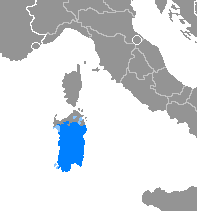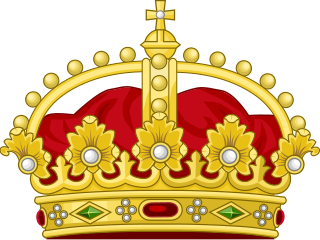This article needs additional citations for verification .(September 2014) (Learn how and when to remove this template message) |
The Crown of the Realm (Sardinian: Corona de Logu) was a political institution in Sardinia that acted as legislature during Sardinia's Giudicati era. [1]

Sardinian or Sard is the primary indigenous Romance language spoken by the Sardinians on most of the island of Sardinia. Many Romance linguists consider it the closest genealogical descendant to Latin. However, it also incorporates a Pre-Latin substratum, as well as a Byzantine Greek, Catalan, Spanish and Italian superstratum due to the political membership of the island, which became a Byzantine possession followed by a significant period of self-rule, fell into the Iberian sphere of influence in the late Middle Ages, and eventually into the Italian one in the 18th century.
It was made up of the majorales (or "wise men") of each region, including the curadores and the majores (or "aldermen") as well as the local píscamos (who acted more like high prelates), [2] and existed to advise the judiches . The majorales were usually either relatives of the judiche or belonged to reliable local families. In essence, it was more-or-less identical to the witenagemot of Anglo-Saxon England in both its composition of officials and its purpose. The Crown nominated the "Deemster King" Judiche, and attributed the supreme power, maintaining the powers to ratify the acts and the laws which regarded the whole realm.
A bishop is an ordained, consecrated, or appointed member of the Christian clergy who is generally entrusted with a position of authority and oversight.

The Witenaġemot, also known as the Witan was a political institution in Anglo-Saxon England which operated from before the 7th century until the 11th century. The Witenagemot was an assembly of the tribe whose primary function was to advise the king and whose membership was composed of the most important noblemen in England, both ecclesiastic and secular. The institution is thought to represent an aristocratic development of the ancient Germanic general assemblies, or folkmoots. In England, by the 7th century, these ancient folkmoots had developed into convocations of the land's most powerful and important people, including ealdormen, thegns, and senior clergy, to discuss matters of both national and local significance.
The Supreme Magistrate of the Crown was the "Deemster King" Judiche, although they could be substituted for a curadore or a majore if need be. The moots were in the capital (or wherever the judiche lived).
The Sardinian word logu literally means "place", but when capitalised it refers to a judicadu . It is derived from Latin locus (originally "stlocus" in Old Latin) from Proto-Indo-European *stel- ("to place", "to locate").

Old Latin, also known as Early Latin or Archaic Latin, refers to the Latin language in the period before 75 BC, i.e. before the age of Classical Latin. It is ultimately descended from the Proto-Italic language.

Proto-Indo-European (PIE) is the linguistic reconstruction of the common ancestor of the Indo-European languages, the most widely spoken language family in the world.












